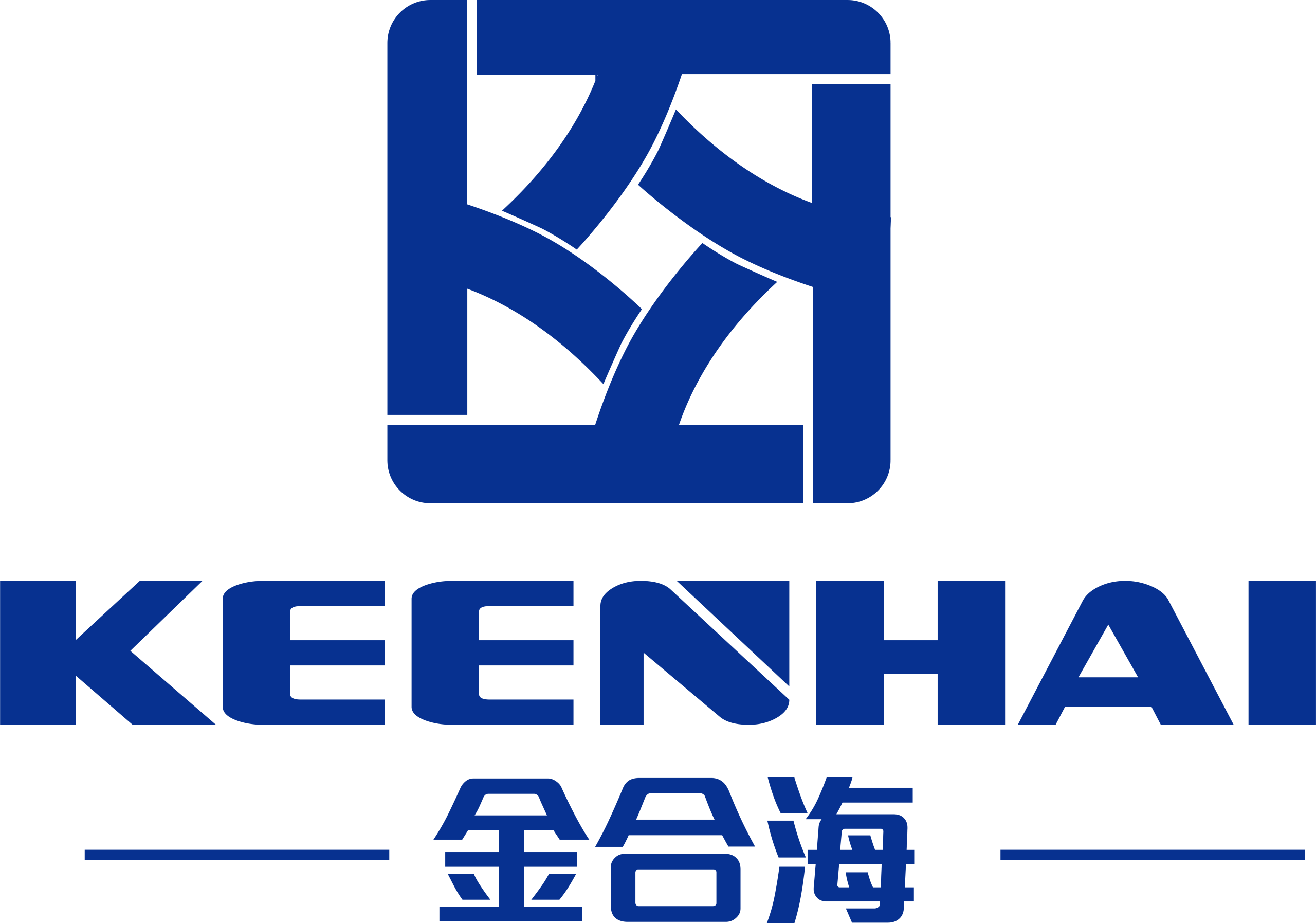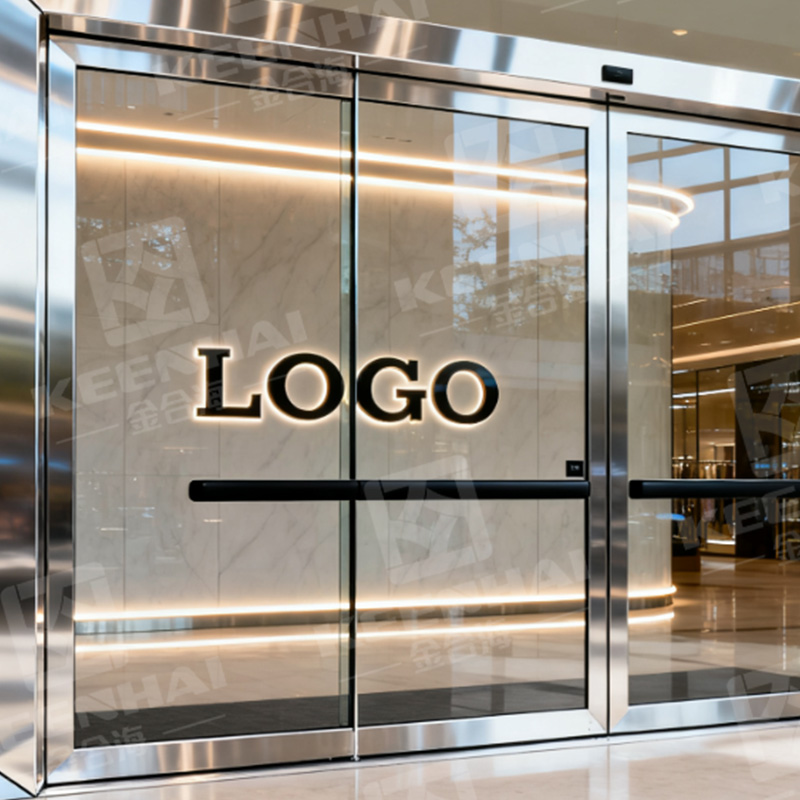Custom PVD stainless steel sheet options include brushed gold, laser-etched black, and 20+ colors, all with superior durability.
What Customization Options Are Available?
Color and Finish Variations
Color is the cornerstone of customization when it comes to PVD stainless steel sheets. Thanks to the precision of Physical Vapor Deposition technology, clients can select from an impressive spectrum that includes titanium gold, champagne, rose gold, sapphire blue, emerald green, charcoal black, and more. Each tone maintains high stability under both indoor and outdoor exposure, making it ideal for architectural and interior applications.
Finishes go far beyond a simple mirror or brushed surface. Common options include mirror polish (#8), hairline, satin, bead-blasted, etched, and even antique copper or brass-like textures. These aren’t superficial treatments—they alter light reflection, fingerprint resistance, and even scratch visibility. For instance, a hairline finish is more suitable for high-traffic environments due to its resistance to minor abrasions, while mirror polish is often reserved for aesthetic highlights and luxury installations.
The advanced coating process on Bileag stàilinn gun staoin maintains both color intensity and surface hardness. A 2019 study by Tsinghua University found that PVD-coated finishes can last over 15 years without significant fading, even in humid or coastal climates.
Every finish type impacts durability, visual warmth, and reflection. Here’s a simplified breakdown of common finishes:
| Seòrsa Crìochnachaidh | Gloss Level | Scratch Resistance | Common Uses |
|---|---|---|---|
| Mirror Polish | High | Low | Elevators, luxury panels |
| Hairline | Meadhanach | High | Doors, columns, exteriors |
| Bead Blasted | Matte | Meadhanach | Decorative walls |
| Etched | Variable | Meadhanach | Signage, branding panels |
Surface Patterns and Textures
Texturing and pattern engraving add depth and individuality to what would otherwise be a uniform metallic surface. These are not painted graphics or decals. The designs are chemically etched or mechanically pressed into the metal, creating tactile depth and contrast between reflective and matte areas. Available styles include wave lines, geometric grids, floral motifs, custom logos, and even 3D illusions.
Using CNC micro-engraving, companies like stàilinn gun staoin pvd can produce extremely detailed surface etching with up to 600 DPI resolution, which is more than enough for intricate branding, art installations, or hotel interior walls.
The customization process typically follows these steps:
-
Client submits a design file (.AI or .DXF formats are preferred).
-
Material is prepared with a base finish (commonly mirror or brushed).
-
Etching or embossing is executed using CNC or acid treatment.
-
Final PVD coating is applied to seal the design and protect from wear.
This process maintains both the visual integrity of the design and the physical durability of the Plàta Meatailt Stàilinn gun Mheirg. For high-end retail environments or hospitality design, patterned plates are an easy way to add sophistication without sacrificing performance.
Thickness and Dimensions
PVD stainless steel sheets come in a wide range of thicknesses, typically between 0.3 mm to 3.0 mm, and can be further customized for specialized applications. For cladding and elevator panels, 0.8 mm to 1.2 mm is the most common range. Thicker gauges like 2.0 mm or 3.0 mm are generally used for countertops, partitions, or structural panels.
The standard size of a sheet is usually 1219 mm x 2438 mm (4′ x 8′), but custom dimensions are absolutely possible. Some suppliers offer lengths up to 4000 mm and widths as broad as 1500 mm. Tolerance in cutting precision typically stays within ±0.5 mm. That level of control allows seamless wall panel applications or complex ceiling systems where alignment is critical.
Dimension customization supports specific project constraints, whether you’re wrapping a radius wall or installing flush panels in elevator interiors. With Duilleag Stàilinn gun Mheirg, clients often request nonstandard cuts to eliminate waste and minimize on-site modifications.
Cut-to-Size Services
Cutting to precise measurements is not just convenient—it’s critical in high-efficiency fabrication environments. Instead of ordering full-size sheets and manually cutting them down on-site, many clients prefer to receive pre-cut panels based on exact blueprints. This reduces installation time, labor cost, and material waste.
Modern suppliers use high-powered fiber laser systems or water-jet cutters, which offer tolerance down to ±0.1 mm. These machines also allow for nonlinear shapes, internal cutouts, and bevels. For example, backlit signage, decorative screens, and intricate retail displays often involve dozens of unique shapes cut from the same batch of sheets.
Here’s how a typical cut-to-size order is processed:
-
Customer submits CAD drawings or a cut list.
-
Material type, finish, and thickness are confirmed.
-
Each sheet is processed using CNC equipment.
-
Edges are cleaned and protected before shipping.
In a 2024 customer report by a U.S.-based architectural firm, pre-cut PVD panels saved an average of 21% in total installation cost due to faster fitting and minimal wastage. That kind of precision makes custom sheet work not just an aesthetic upgrade, but a financially sound decision.
Every detail—from color to shape—can be tailored. If it’s made of stainless steel, it can be made your way.
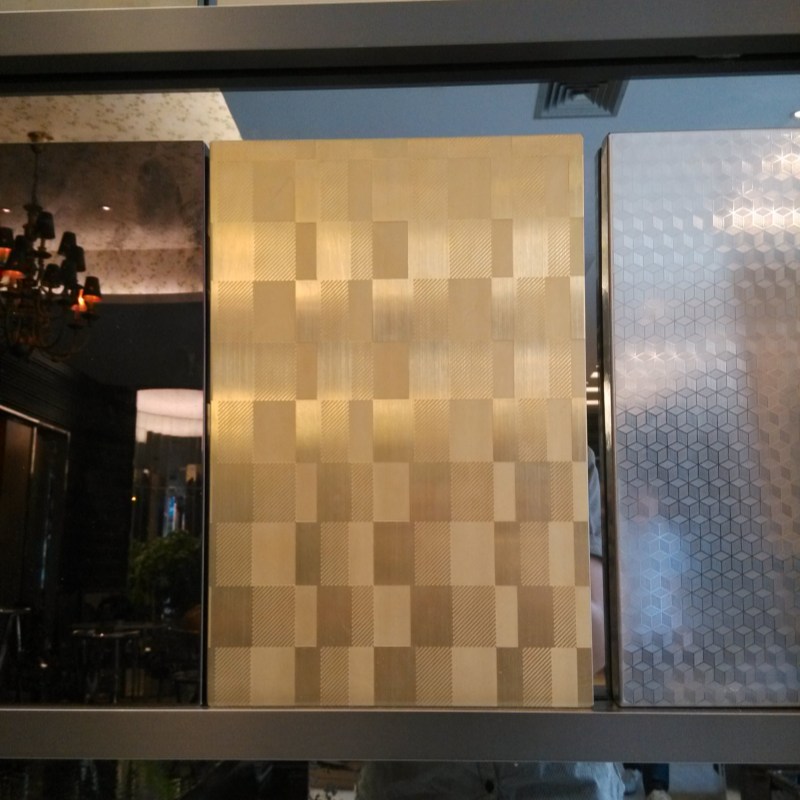
How Does the Customization Process Work?
From Design Concept to Fabrication
Every customized PVD stainless steel sheet starts with a precise concept and ends with a ready-to-install product—but what happens in between is where the value is created. This process demands accuracy, material knowledge, and an understanding of aesthetic goals. Most projects begin with a digital file, either a CAD layout or a vector-based graphic. These files must align with the chosen thickness, surface finish, and cutting capabilities of the production line.
A complete fabrication cycle typically involves these six core steps:
-
Technical Consultation – Clients define the color, finish, dimensions, and surface effects needed. Professionals evaluate feasibility based on coating capability and material behavior.
-
Material Selection – Common options include 304 and 316 grades. 316 is ideal for coastal or high-humidity environments due to its superior corrosion resistance.
-
Base Surface Treatment – Sheets undergo grinding, brushing, or polishing to prepare for coating or texturing. This step determines the final reflection and fingerprint resistance.
-
Surface Customization – Designs are etched, embossed, laser-cut, or bead-blasted. Each technique alters texture, depth, and light behavior.
-
PVD Coating Application – The surface enters a vacuum chamber where metal ions deposit a high-density color layer. This step requires temperatures up to 500°C and precise argon gas control.
-
Quality Control & Packing – After inspection under ISO 9001:2015-certified standards, protective films are applied. Sheets are packed in moisture-resistant crates for international shipment.
From first sketch to final panel, the process can take 7 to 25 working days depending on complexity. For example, mirror-polished panels with logo etching and gold coating typically require 15+ days. You can browse applications and finishes through Bileag stàilinn gun staoin galleries to better align expectations with technical possibilities.
In-House vs. Outsourced Customization
Where the customization takes place makes a measurable difference in both turnaround time and quality control. When manufacturers handle everything in-house—from surface prep to final packaging—clients benefit from a shorter supply chain, real-time revisions, and consistent output. Outsourcing, on the other hand, often means longer lead times, disjointed communication, and potential quality inconsistencies due to multiple vendors touching the material.
A direct fabrication setup can reduce production delays by up to 38%, based on a 2023 industry survey by the Sheet Metal Association of Asia. The cost per square foot is also typically lower when processes are centralized under one roof, due to reduced double-handling and packaging redundancy.
Here’s a real-world comparison between in-house and outsourced workflows:
| Factor | In-House Process | Outsourced Fabrication |
|---|---|---|
| Average Turnaround Time | 7–14 business days | 15–28 business days |
| Unit Cost (USD/sq. ft) | $12–$20 | $18–$30 |
| Quality Consistency | High | Variable |
| Communication Efficiency | Direct with engineering team | Multi-step via sales + vendor chain |
| Revision Flexibility | Same-day or next-day adjustment | 3–7 days minimum |
Choosing in-house services like those offered by stàilinn gun staoin pvd isn’t just about saving money—it’s about maintaining creative and technical control from start to finish.
Typical Lead Times and Order Minimums
Production timeframes for customized stainless steel vary significantly based on the type and depth of customization. Simple color finishes on standard-sized sheets (1219 x 2438 mm) can be completed within 5 to 7 working days. If the order includes complex etching, laser cutting, or nonstandard sheet dimensions, expect lead times of 10 to 25 working days.
Order minimums also depend on both the customization type and the supplier’s capacity. For PVD color coating alone, many factories offer a minimum order quantity (MOQ) as low as 10–15 sheets per color. However, when combined with custom patterns or laser-cut shapes, the MOQ can jump to 30–50 sheets, due to machine setup costs and material preparation.
Clients looking for samples or pilot runs may request one-off customizations, but the price per sheet in these cases rises steeply. A single test sheet with PVD coating and etching may cost $280–$400, depending on the complexity.
Budget-conscious clients often find it more efficient to batch custom orders and lock in pricing early. Lead times can fluctuate based on seasonal demand. During peak construction months (typically May through October), some production lines run at 95% capacity, increasing lead times by 20–40%. Planning ahead is the only way to maintain control over both deadlines and material availability.
For those working under strict timelines or with high-end specifications, communicating clearly and early with the production team is essential. Whether you’re working with a Plàta Meatailt Stàilinn gun Mheirg supplier or a full-spectrum manufacturer, knowing your schedule—and your supplier’s schedule—can be the difference between a successful launch and a delayed install.
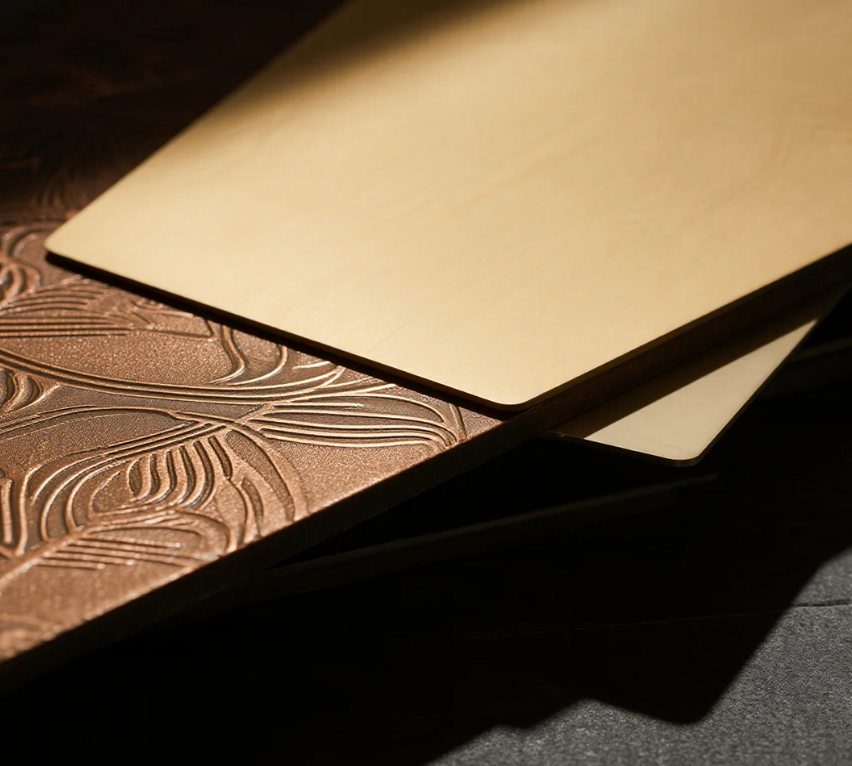
Which Technologies Enable Customization?
PVD Coating Techniques
PVD (Physical Vapor Deposition) is the core technology behind the vibrant, ultra-durable finishes on customized stainless steel sheets. This vacuum-based process involves vaporizing a solid metal—like titanium or zirconium—and bonding it atom by atom to the surface of the stainless substrate. The result is a dense, scratch-resistant coating that doesn’t peel, chip, or fade like traditional paints or electroplating.
In a tightly controlled chamber, temperatures reach 450–600°C, and argon or nitrogen gas helps carry metal ions onto the sheet. The coating can be tuned to achieve over 15+ distinct color tones, from gold and black to sapphire blue and emerald green. Unlike spray coatings, PVD adds only 0.2–0.5 microns of thickness, preserving the precise dimensions of the sheet while boosting surface hardness up to HV 1800 (compared to standard stainless steel’s HV 200–300).
This technique is the reason why products like Bileag stàilinn gun staoin can survive exterior cladding, marine environments, and high-traffic interiors without fading or scratching.
PVD isn’t just about color—it also enhances wear resistance, corrosion performance, and fingerprint resistance when paired with specific finishes like nano-coating or brushed surfaces.
CNC Cutting and Laser Engraving
CNC and laser technologies give designers full control over how stainless steel is shaped, patterned, and personalized. These machines cut or engrave materials using precision-level programming, with tolerances as tight as ±0.05 mm—perfect for intricate signage, branded elements, or architectural panels that require millimeter-perfect alignment.
CNC (Computer Numerical Control) routers are ideal for cutting thicker steel sheets (2.0 mm and up) into complex profiles, such as lattice screens, ventilation grilles, or decorative room dividers. They operate with rotating carbide or diamond-tipped tools and support multi-axis movement for three-dimensional shaping.
Laser engravers, especially fiber lasers, are faster and more precise for surface marking or through-cuts. A 1000-watt fiber laser can cut up to 3 mm stainless steel at speeds over 25 mm/s while maintaining crisp, burr-free edges. These systems also allow grayscale engraving, so subtle branding, QR codes, or artistic details can be burned directly onto the surface without affecting finish durability.
Here’s a quick tech comparison:
| Technology | Precision (mm) | Best for | Sheet Thickness Range |
|---|---|---|---|
| CNC Router | ±0.1 | Cut-outs, perforations, frames | 1.0 – 8.0 mm |
| Fiber Laser Engraver | ±0.05 | Logos, fine graphics, QR engraving | 0.3 – 3.0 mm |
Every high-end customized panel you see in retail stores or hotel lobbies likely started on one of these machines. Whether cutting a ventilation slot or engraving a multi-layer logo, this level of customization can’t be achieved by hand or standard fabrication tools.
Brushing, Etching, and Embossing Methods
Surface texture is just as vital as shape and color in stainless steel customization—and that’s where mechanical and chemical treatments come in. Brushing, etching, and embossing each play a unique role in defining the feel, reflectivity, and dimensional effect of the material.
Brushing creates fine, linear abrasions across the surface using belt grinders or scouring wheels. This gives the metal a matte, directional grain—ideal for fingerprints resistance in high-contact applications like door panels or appliance covers.
Etching involves applying an acid or salt-based solution to the metal’s surface to selectively remove material. With the help of masks or UV photoresist layers, this method creates high-contrast designs, shadow effects, or negative-space artwork. The depth is usually between 0.02 to 0.1 mm, enough to feel texture with your fingers.
Embossing, on the other hand, is a mechanical process using dies to stamp three-dimensional reliefs onto the sheet. It’s often used to create wave textures, honeycomb patterns, or industrial grids on elevator interiors and ceiling panels. The raised areas typically protrude 0.3 to 1.2 mm, depending on the die depth and sheet thickness.
When properly sequenced—such as brushed + etched + PVD coating—these methods combine into multi-layered, ultra-premium finishes that feel as good as they look. You’ll often see this level of detail in bespoke architectural projects, branded displays, and artistic metal walls.
Whether you’re sourcing from a global supplier or a custom fabricator, these finishing technologies define the tactile and visual impact of your final product.
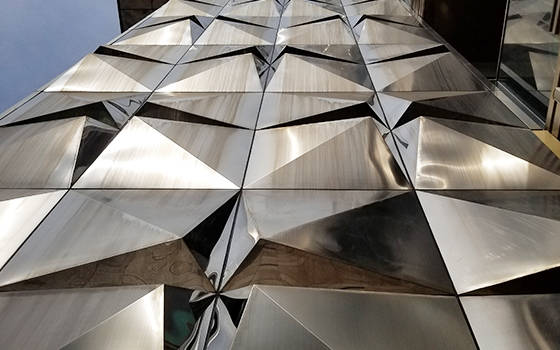
Are There Limitations in Customizing PVD Sheets?
Technical Constraints by Material Type
Not every stainless steel grade performs equally well under PVD treatment. The most commonly used materials for PVD coating are Stàilinn gun smal 304 agus 316, primarily because of their uniform surface chemistry, thermal tolerance, and corrosion resistance. While 201 grade is cheaper and widely available, it often produces uneven coating and suffers from lower corrosion resistance post-treatment.
The base material needs to maintain structural stability at temperatures up to 600°C during the PVD process. Lower-quality alloys with variable nickel or manganese content can distort, discolor, or develop surface defects under vacuum and heat. For architectural cladding or decorative panels, 304 is generally the minimum standard. For marine or poolside installations, 316 is non-negotiable due to its higher molybdenum content and superior salt resistance.
Some specialty finishes or effects—like deep etching or high-gloss mirror polish—are only feasible on 304/316-grade substrates with a thickness of at least 0.8 mm, as thinner materials tend to warp or develop microfractures under pressure and heat.
| Ìre Stuth | Suitable for PVD Coating | Frith-aghaidh creimeadh | Ideal Use Cases |
|---|---|---|---|
| 201 | Partially | Low–Moderate | Indoor low-traffic decor |
| 304 | Yes | High | Elevators, hotel interiors |
| 316 | Sàr-mhath | Glè Àrd | Facades, marine, outdoor structures |
Cutting corners on the material type often results in coating failure, uneven color tone, or poor bonding quality. It’s critical to match the material to the performance environment before even considering customization.
Durability and Color Consistency Concerns
While PVD finishes are engineered to be more durable than traditional plating, they’re not invincible. The final outcome largely depends on the precision of the vacuum environment, coating thickness, and post-treatment protection layers.
For instance, inconsistent gas flow or unstable chamber temperature during deposition can result in color deviation across batches, particularly with sensitive shades like rose gold or champagne. Variations of 2–5% in reflectivity or hue are common when sheets are produced in different runs, which creates a challenge for projects requiring perfect visual uniformity over large surface areas.
Wear resistance is high, but not absolute. On average, PVD-coated surfaces reach hardness values between HV 1800–2200, significantly outperforming non-coated stainless surfaces. However, repeated impact or bending post-coating can still cause microcracks or edge flaking, especially near drilled holes or laser-cut corners. This is why cutting or shaping should be completed before PVD application, not after.
For high-traffic applications like elevator interiors or public handrails, a nano anti-fingerprint coating (AFP) is often applied on top of the PVD layer. It adds protection against smudges and acids, but increases cost by 15–20% and may slightly alter the perceived gloss.
Every aesthetic or performance upgrade has a trade-off—understanding those limits helps prevent costly surprises in the field.
Availability of Rare Finishes or Sizes
Customization doesn’t mean unlimited choices—certain colors, textures, and dimensions are either hard to source or require extensive lead times. For example, colors like emerald green, bronze matte, or gunmetal black are not widely stocked. These tones typically require a dedicated PVD run, with a minimum order of at least 30–50 sheets per color and lead times of 20–35 working days, depending on machine availability.
Ultra-large formats are another constraint. While the standard size is 1219 mm × 2438 mm (4′ × 8′), some clients demand extended lengths up to 4000 mm or widths beyond 1500 mm. Not every factory supports oversized vacuum chambers, which limits availability to only a few high-capacity producers in China, Germany, or South Korea.
Custom surface patterns—like deep-etched floral designs or 3D optical textures—require exclusive die sets or custom masking stencils. Fabricating those tools adds $800–$1500 in upfront cost, making them more practical for bulk orders or branded installations, not small projects.
Even the best customization services still operate within physical, technical, and economic constraints. The key is planning early, budgeting realistically, and working with vendors who clearly state their capabilities and limitations.
When it comes to high-precision PVD customization, choosing the right partner matters just as much as the material itself. Whether you need deep-etched floral patterns, rare metallic finishes, or oversized architectural panels, Foshan Keenhai Metal Products Co. offers end-to-end solutions that cover design consultation, surface processing, and high-quality PVD coating—all under one roof. With consistent quality and global project experience, they’re the name serious designers trust.
Back to basics: What is a PVD stainless steel sheet?
